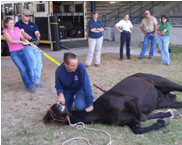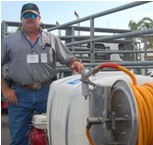
Vol. 7, No.1, January 2011 |
 Printer-Friendly PDF Version Printer-Friendly PDF Version |
"Building a Better Team"
Register for 2011 Florida SART Planning Meeting
 The Altamonte Springs-Orlando North Hilton is a Florida green hotel and conference center.
The Altamonte Springs-Orlando North Hilton is a Florida green hotel and conference center.
It isn’t too late to register for the 2011 SART Planning Meeting February 28– March 2…but it is getting awfully close! The Altamonte Springs–Orlando North Hilton, a Florida green hotel and conference center, is the 2011 host hotel.
- Room rates just $93/per night.
- No event fee for registered participants, but please go to www.flsart.org to register and book your room (www.flsart.org/hotel). This needs to be done right away and in no case later than January 28 to be eligible for SART’s group rate.
- There’s a light fare reception the evening of February 28 and, due to the generosity of several sponsors, complimentary breakfasts will be served on March 1 and 2. On March 1 during the SART awards ceremony, lunch is also complimentary.
Agenda
 John Haven addresses the 2009 SART Conference. John Haven addresses the 2009 SART Conference.
|
"The Planning Meeting is a unique opportunity for all of the stakeholders from ground floor up, and including the NGOs, to
get in a room and discuss the issues," says John Haven, Director of the UF Veterinary Medical College. "It is where the counties can learn from each other, the state can learn what problems are common to the counties and maybe a more coordinated solution is needed, and NGOs can really show where they add value. This Planning Meeting's Agenda is a direct result of the feedback given from the attendees of the last one. There is training, but there are also sessions dedicated to discussion and interaction on key issues."
|
| Monday | ||||
| 1:00 - 5:00 pm | - Welcome: Dr. Tom Holt, State Veterinarian | |||
| 6:30 - 7:30 pm | SART Mixer | |||
| Tuesday | ||||
| 8:00 am - Noon | Problem solving working groups | |||
| Noon | Awards Luncheon (Photo at right: Laura Bevan, HSUS, receives SART Service Award from 2009 SART conference co-chair Dr. Joan Dusky, UF-IFAS. Also receiving awards and not pictured were Dr. Suzan Loerzel, John Haven and Dr. Terry Spencer.)
 | |||
| Afternoon | Field training | |||
| ||||
| Wednesday | ||||
| 8:00 am - Noon | MOU between FVMA & FDACS | |||
Questions? Check with Michael Turner (850) 410-6761 (turnerm@doacs.state.fl.us) or Joe Kight (kightj@doacs.state.fl.us). A Florida green hotel and conference center, the Hilton Orlando/Altamonte Springs has a web site at http://www1.hilton.com/en_US/hi/hotel/ALTAHHF-Hilton-Orlando-Altamonte-Springs-Florida/index.do.
 Dr. Jenifer Chatfield, DOH (l) and Planner John Burkett, Agricultural Emergency Preparedness discuss SART options at a recent Advisory Board meeting.
Dr. Jenifer Chatfield, DOH (l) and Planner John Burkett, Agricultural Emergency Preparedness discuss SART options at a recent Advisory Board meeting.
What can you expect from the 2011 Planning Meeting? "Emergency care and first aid for many different species commonly encountered in Florida backyards will be covered," says Jenifer Chatfield, DVM, Veterinary Agriculture Liaison with the Department of Environmental Health about her Tuesday afternoon session. "Attendees will have the opportunity to submit questions for the speakers to be answered during the final hour of the workshop. It should be a fun environment that encourages interactive learning and discussion rather than just straight lecture."
Why attend? Not only will the latest information be available on local, state and national emergency planning efforts for animals and agriculture, but here are some of the agencies and individuals that will be represented – most of whom you will interact with as you plan for and eventually respond to emergency situations in your jurisdiction:
- County Emergency Management Directors – more than half of the state’s 67 county emergency management groups will be represented
- County Agricultural Extension Directors – more than half of the agricultural offices of the state have already registered
- State and Federal Agency personnel – FDACS, USDA, University of Florida, Fish and Wildlife Conservation Commission, the SART Sentinel, Texas Dept. of Agriculture
- Many private veterinary and response personnel
[top]
Course Offering - MGT 337
Agriculture and Food Vulnerability Assessment Training
Prepared by the University of Tennessee College of Veterinary Medicine and sponsored by FDACS’ Office of Agricultural Emergency Preparedness MGT 337 - Agriculture and Food Vulnerability Assessment Training teaches participants how to use the Carver + Shock vulnerability assessment methodology to assess food and agriculture facilities.
Date & Time: Tuesday, February 8 (8:00 am - 5:00 pm with a one-hour lunch break) and Wednesday, February 9 (8:00 am – 1:00 pm)
Place: Broward County Emergency Operations Center, Room 332-B, 201 N.W. 84th Ave., Plantation, FL 33324
Description: This 1 ½ day free course helps food regulation, law enforcement and industry personnel to prevent and deter terrorist and criminal acts that target the food industry. Participants will learn to use the CARVER + Shock method to perform detailed vulnerability assessments of agricultural facilities. Realistic, hands-on training uses videos of actual facilities and interactive case studies with practical exercises. You learn to assess vulnerabilities on a community and individual facility level, and to identify and implement mitigation measures to reduce vulnerabilities.
Primary audience : "Personnel from agriculture and food industry; law enforcement and the military; emergency management; public health; federal, state, county and local officials; extension and crop specialists; agricultural crime units and others involved with food and agriculture security planning.
Deadline to register: January 31
For additional course information, access the following link: http://www.vet.utk.edu/cafsp/FoodVulnerabilityAssessment/index.php.
Registration/Questions:www.flsart.org/mgt337. Email the completed registration form to burketj1@doacs.state.fl.us or fax it to (850) 245-1391, attention John Burkette (850) 245-1387.
PS: The Office of Agricultural Emergency Preparedness will offer this course again in Orlando on May 11-12.
[top]
Al Qaeda at the Salad Bar?
 Once a restaurant staple, many establishments have closed their salad bars because of public health concerns. Nevertheless, no less a personage than First Lady Michelle Obama recommends them for public schools.
Once a restaurant staple, many establishments have closed their salad bars because of public health concerns. Nevertheless, no less a personage than First Lady Michelle Obama recommends them for public schools.
In the response business one has to be careful about what makes the blood pressure rise. Consider this: A December 22nd CNN report said the al Qaeda terrorist organization has contemplated “spreading poison on salad bars and buffets at hotels and restaurants,” but, according to the report, “un-named government sources” said the information was months old and had only been a discussion item on the terror group’s menu of options.
That Al Qaeda considered using ricin and cyanide was apparently confirmed by DHS. In response, DHS met with “representatives of the hotel and restaurant businesses.” The U.S. source did not “know of any current plotting along these lines,” but a CBS report – also quoting an unnamed intelligence official called the threat “credible.”
DHS spokesman Sean Smith said planners and responders have “engaged in extensive efforts for many years to guard against all types of terrorist attacks, including unconventional attacks using chemical, biological, radiological and nuclear materials.”
Go to http://edition.cnn.com/2010/US/12/21/al.qaeda.poison.plot/?hpt=T2 to read the full CNN report including a video.
“I received 50 plus emails on the CBS story,” says Art Johnstone, Director of FDACS’ Office of Agricultural Emergency Preparedness. “The bottom line: It was a news report that took information out of context, and misquoted Homeland Security officials to sensationalize some routine, For Official Use Only information (FOUO).
“Our agency did not provide any guidance to industry, deciding it would be alarmist to do so, given the media attention already being given this story. The original FOUO information was distributed to our lab folks back in November when it was released, and the appropriate, background level food analysis work continues to be done.”
What is ricin?
 The Castor-bean plants (scientifically called Ricinus communis) are still purchased everywhere though they contain the deadly toxic Ricin.
The Castor-bean plants (scientifically called Ricinus communis) are still purchased everywhere though they contain the deadly toxic Ricin.
 Essence of apricot kernels contains cyanide which occurs naturally in sugars, cassava roots, large fruit pits and tobacco leaves.
Essence of apricot kernels contains cyanide which occurs naturally in sugars, cassava roots, large fruit pits and tobacco leaves.
Ricin is a toxic protein extracted from the shell casing of beans of the castor oil plant,Ricinus communis. It is fairly easy to produce either as a white powder or a liquid in crystalline form by purifying it from castor-oil manufacturing waste. The aqueous phase left over from oil extraction, the “waste mash,” contains 5-10 percent ricin. Separation requires only simple chromatographic techniques.
Because one milligram may kill an adult, ricin has the potential to be a large-scale murder weapon (though not as effective as anthrax or botulinum). Victims manifest nausea, emesis, diarrhea, tachycardia, hypotension and seizures persisting for up to a week. (Ricin was used to assassinate Bulgarian dissenter Georgi Markov in the U.K. in 1978 using a weapon disguised as an umbrella.)
What is cyanide?
Cyanide occurs naturally in sugars, cassava roots, large fruit pits and tobacco leaves. In various forms and combinations it is used in many industrial applications and can be stored as a liquid, solid or gas. The infamous “suicide pills” used by spies – mostly perhaps in novels – were usually derived from prussic acid, a form of hydrogen cyanide.
Because cyanide, especially hydrogen cyanide, is produced naturally, it is difficult to avoid exposure completely. Long-term exposure to smoke, for example – forest fires or cigarettes – is dangerous, since hydrogen cyanide gas is a natural by-product of combustion. Liquid cyanide in insecticides and industrial cleaners can cause localized rashes and blister on exposed skin.
WW II era Nazis used a form of hydrogen cyanide (commercially, “Zykon B”) in gas chambers and it may have been used by Saddam Hussein to kill thousands of Kurds during an uprising in the late 1980s.
While ricin and cyanide can sicken or even kill people, neither is considered a weapon of mass destruction, said Randall Larsen, a homeland security expert in a widely circulated follow up report.
[top]
2011 Schedule of Agroterrorism Preparedness Classes
Florida’s Department of Agriculture and Consumer Services (FDACS) Office of Agricultural Emergency Preparedness partners with the Western Institute of Food Safety and Security (WIFSS) to present DHS Certified Agroterrorism Courses.
All courses are free. On-site registration begins at 8:00 am and, unless otherwise specifically advertised, workshops end at 4:00 pm. Additional sponsoring partners include the Institute for Food and Agricultural Sciences (IFAS-Extension), the Florida Department of Health and the Regional Domestic Security Task Forces. The following courses are still open:
AWR-154 Principles of National Incident Management System,
Team Building, and Risk Communication
Tuesday, February 5, 2011
Escambia County Public Safety, 6575 North "W" St., Pensacola
AWR-155 Principles of Frontline Response to Agroterrorism
and Food Systems’ Disasters
Wednesday, January 19, 2011
Hillsborough County Extension Office, 5339 S CR 579, Seffner
Thursday, January 20, 2011
Orange County Sheriff's Office Central Operations Center, Mel Martinez Auditorium, 2500 W Colonial Dr., Orlando
Wednesday, February 16, 2011
Florida Department of Agriculture and Consumer Services, Conner Administration Building (Eyster Auditorium), 3125 Conner Blvd., Tallahassee
Tuesday, March 15, 2011
Jacksonville Regional Operations Center, 921 N Davis St. Building E, Jacksonville
Wednesday, March 16, 2011
USDA Farm Service Agency, 4401 NW 25th Place, Suite M Gainesville
To register for a course or for more information go to the WIFSS website at:
Registration:
http://wifss.ucdavis.edu/agroterrorism/classes/classesbydate.php
Course Information:
http://wifss.ucdavis.edu/agroterrorism/classes/course_desc.php
Contact John Terry (850-410-6756 or terryj1@doacs.state.fl.us ) with questions.
[top]
2011 Advisory Board Meetings Scheduled
Florida SART has set the dates for its 2011 Advisory Board meetings. Please put Wednesday, April 6 and Wednesday, September 14 on your calendar. Meetings begin promptly at 10:00 am and should adjourn not later than 2:00 pm. Both meetings will be held in the Board Room of the Florida Farm Bureau adjacent to Interstate 75 in Gainesville. The Farm Bureau cafeteria is available for those who wish to lunch on site.
For information contact Joe Kight, Senior Management Analyst II/ESF-17 ECO, Division of Animal Industry, 407 S Calhoun St., Tallahassee, Fl. 32399-0800 (850) 410-0920 joe.kight@freshfromflorida.com.
[top]
Adam Putnam is new Commissioner
at Department of Agriculture & Consumer Services
 Florida Commissioner of Agriculture and Consumer Services Adam Putnam
Florida Commissioner of Agriculture and Consumer Services Adam Putnam“There is much to be done for our state to create a climate for businesses to succeed and families to thrive,” Adam Putnam writes. “Agriculture is more than a traditional base of our economy; it is a vital and dynamic part of Florida’s bright future. Fostering these new employment opportunities, stewarding our state’s resources and protecting Floridians from those who would prey on them will be my daily focus.”
Born in Bartow in 1974 Adam Putnam graduated from Bartow High School and attended the University of Florida, graduating with a Bachelor of Science in food and resource economics.
A republican, Putnam served in the Florida House of Representatives from 1996 to 2000 and is the former U.S. Representative for Florida's 12th congressional district, serving from 2001 until 2011. He is a member of the Republican Party and replaces Charles Bronson.
[top]
And In the Keystone State…

The Pennsylvania State Animal Response Team (http://sart.cas.psu.edu/ - formerly www.pasart.org) “is a coordinated effort between several governmental, corporate, and private entities dedicated to the preparation, planning, response, and recovery of animal emergencies in Pennsylvania. The team's mission is to develop and implement procedures and train participants to facilitate a safe, environmentally sound and efficient response to animal emergencies on the local, county, state, and federal level.”
“County Animal Response Teams or CARTs are the most critical aspect of SART,” says executive director Joel Hersh c-jhersh@state.pa.us. “The best response is always a local response! Each county is encouraged to form their own CART that can organize volunteers and donations in their local area. Counties are requested to submit their Animal Response plans for viewing and review.”
An example of Pennsylvania responders at work occurred when a horse fell through the ice into a pond in Washington County. Here are the dramatic rescue photos:
 | 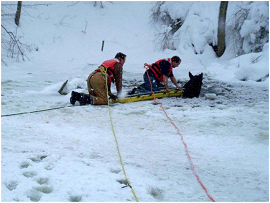 |
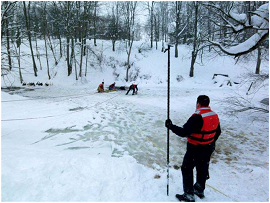 |  |
[top]
...... Caught On Radar ......
Several items to keep on the radar screen because they fall within the “all-hazard disaster” planning, preparation and response scope of SART and its cooperating partners:

1.New Email Addresses at FDACS
With a new commissioner of the Florida Department of Agriculture and Consumer Services come new ideas. Newly elected commissioner Adam Putnam has for instance instituted new email addresses for the members of his department. State ESF-17 coordinator Joe Kight – formerly kightj@doacs.state.fl.us – is now Joe.Kight@freshfromflorida.com. Art Johnstone, Director of the Office of Agricultural Emergency Preparedness for FDACS – formerly johnsta@doacs.state.fl.us – is now Art.Johnstone@freshfromflorida.com.

2.Of Water, Strawberries and Freezing Weather
According to an email from Liz Serca, NASAAEP vice president and assistant secretary, The NASAAEP Animal Emergency Response Library is being developed by the Training Best Practices Working Group and the Center for Food Security and Public Health at Iowa State University. The Library will house information about training opportunities in Animal Emergency Response as well as documents and reference materials. Documents and materials developed by the Best Practices Working Groups will also be available through the Library. The library is accessible on line at http://www.learn.cfsph.iastate.edu/dr.
If you would like to submit additional training course information, Liz says, you may log-in to the site using the following case sensitive username and password: Username: data - Password: nasaaepdata.
Items submitted to the Library will be reviewed by members of the applicable Best Practices Working Group before posting to the Library. If you have questions or comments about the Library, please contact Dr. Cheryl Eia at ceia@iastate.edu.

3.Does your agency or organization have individuals who are bi-lingual in English and Spanish?
Although Florida does not share a border with Mexico, it is a short air flight from Cancun to Tampa. More important however, a significant leg of our agricultural economy depends on Spanish-speaking guest workers from that region and the Caribbean, and Florida is considered – with Texas and California – a “sending state” through which agricultural workers funnel northward as crops ripen. These agricultural workers may begin with citrus or tomatoes and work northward in tobacco, cherries and blueberries.
How many of America’s estimated 13 million guest agricultural workers live in or funnel through Florida? A 20-year old survey by U.S. HHS placed the number at 435,373 traveling migrant and seasonal farm workers and their families (many of whom, by the way own pets).
A more recent study by the Shimberg Center for Affordable Housing at UF www.shimberg.ufl.edu estimated the number of migrant farm workers and their dependents to be smaller, but a still very significant number at 179,185.
Does your county or organization have a plan to communicate with these guest workers before and during an emergency? Does your ESF-17 mission include assisting with their pets? Do you know what radio stations they listen to while working in the fields or what months of the year they are present? It is a challenge and an opportunity.
While it might not be directly related, the escalating drug wars in Mexico and Central America threaten to spill over into the U.S. The violence is driven by the demand for illegal narcotics in the U.S. and while that is essentially a police, immigration and health matter, the stream of fleeing immigrants will almost certainly increase until that problem is effectively managed…which does not appear to be on the immediate horizon. Hence the increased need for bi-lingual responders.

4.END - Exotic (Avian) Newcastle Disease
FDACS and local veterinarians are monitoring an outbreak of Virulent Exotic Newcastle Disease (END) in cormorants in Pinellas County. Exotic Newcastle is an extremely contagious and fatal foreign avian disease that affects most bird species but is not life threatening to humans. Human contact may cause minor irritations such as pink eye or skin irritations.
END is often spread from an infected bird to an uninfected bird in the same flock and could affect wild birds, domestic poultry and pet birds like parrots and parakeets. Agriculture Commissioner Adam Putnam encourages Floridians with pet birds or Floridians who visit aviary sanctuaries to be aware of END symptoms. Often, birds with Exotic Newcastle Disease will exhibit coughing, muscular tremors, drooping wings, paralysis, swelling of tissue around the eyes or neck, and discharge from the eyes or beak.
Unless you are specifically trained, the rule of thumb is “Don’t handle sick wildlife.” Information on Exotic Newcastle Disease can be found at http://www.freshfromflorida.com/ai/main/ani_diseases_main.shtml .
If you identify a bird with the above symptoms, contact either: FDACS [850-410-0900 rad@freshfromflorida.com or after hours 1-800-342-5869] or USDA [352-333-3060 vsfl@usda.gov].

5.Foreign Animal Disease Quick Quiz
1. Mad cow disease is technically known as:
a. bovine herpes
b. bovine spongiform encephalopathy
c. exotic cow encephalitic paralysis
2. Exotic Newcastle disease will not affect:
a. wild birds like turkeys
b. domestic birds like parakeets and finches
c. it affects all birds, wild and tame
3. Eastern equine encephalitis or EEE is spread by the bite of:
a. infected mosquitoes
b. biting flies
c. vampire bats
4. Sounding so 18th century, foot and mouth disease (FMD) results in the annual culling of millions of wild and domestic animals. Which animals are resistant to FMD?
a. llama
b. elephant
c. Duroc pig
(Please check the answers at the end of this month’s SART Sentinel)

6.Alfred Hitchcock returns from the dead?
In August 1961, Capitola, California residents awoke to the sounds of birds called sooty shearwaters slamming into their rooftops. City streets were covered with dead birds. Research eventually suggested poisoning from domoic acid, a neurotoxin that can “bio-accumulate” in shellfish and anchovies that feed on certain phytoplankton and then poison mammals which eat the shellfish. Domoic acid may cause short-term memory loss, brain damage and even death. Film producer Alfred Hitchcock based his movie “The Birds” on this incident.
Today authorities are trying to understand what caused as many as 5,000 red-winged blackbirds, starlings and grackles to fall dead out of the sky around Beebe, Arkansas on New Years Eve night. Arkansas’ Livestock and Poultry Commission Lab and the National Wildlife Health Center Lab in Madison, Wisconsin are examining the bird carcasses and initial assessment has indicated “evidence of trauma in the breast tissue” and not a disease or airborne toxin. The birds had formed blood clots, likely due to high-altitude lightning or hail said Commission ornithologist Karen Rowe. It has also been speculated that fireworks may have caused the deaths.
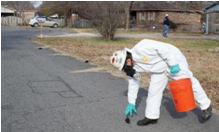
Game & Fish Commission spokesman Keith Stephens says the birds fell in an area about a mile long and a half-mile wide, but that this is not the first time birds have dropped from the Arkansas sky.
Notably, the birds that died in Arkansas are the same species of the birds that a few days later died in Louisiana. Although wildlife officials maintain that the bird and fish incidents are unrelated the mystery has been compounded by the die-off of approximately 83,000 drum fish in the Arkansas River.
The USGS National Wildlife Health Center says this is a natural occurrence in wildlife just that it is never reported on.

7.Russian Architect Designs Modern Ark
In the far reaches of “all-hazard disaster capabilities through partnerships,” a new Ark has been designed by Russian architect Alexander Remizov. The Ark is meant to answer the twin problems of coping with a changing or harsh environment and protecting the environment from human impact. www.cnn.com/2011/TECH/innovation/01/05/eco.ark.building/index.html?iref=NS1.
[top]
About the SART Sentinel |
|
The SART SENTINEL is an E-mail newsletter prepared monthly by the members of the Florida State Agricultural Response Team. Past issues of the Sentinel are archived on the Florida SART Web Site, www.flsart.org. If you have a story or photo that you would like to have considered for publication in The SART SENTINEL, please contact the Editors. Editor: Rick Sapp, PhD, Technical Writer, Florida Department of Agriculture & Consumer Services, Division of Animal Industry [rsa5@cox.net] Associate Editor: Joe Kight, State ESF-17 Coordinator, Florida Department of Agriculture & Consumer Services, Division of Animal Industry [kightj@doacs.state.fl.us] [top]FAD Quick Test Answers & Fast Facts
[BSE learning word: obex – part of the medulla oblongata or the part of the brain that connects to the spinal cord] (NOTE: Brush up on your FAD knowledge by jumping to the FDACS web site at www.freshfromflorida.com/ai/main/ani_diseases_main.shtml. That page not only has information from Florida, but contains specific links to the USDA and also to the World Organization for Animal Health (OIE) web sites.) [top] |

